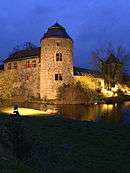Ratingen
| Ratingen | ||
|---|---|---|
| ||
 Ratingen | ||
Location of Ratingen within Mettmann district  | ||
| Coordinates: 51°18′0″N 6°51′0″E / 51.30000°N 6.85000°ECoordinates: 51°18′0″N 6°51′0″E / 51.30000°N 6.85000°E | ||
| Country | Germany | |
| State | North Rhine-Westphalia | |
| Admin. region | Düsseldorf | |
| District | Mettmann | |
| Government | ||
| • Mayor | Klaus Konrad Pesch (Gemeinschaftskandidat von CDU, FDP, die Grünen, SPD[1]) | |
| Area | ||
| • Total | 88.72 km2 (34.25 sq mi) | |
| Population (2015-12-31)[2] | ||
| • Total | 87,943 | |
| • Density | 990/km2 (2,600/sq mi) | |
| Time zone | CET/CEST (UTC+1/+2) | |
| Postal codes | 40878–40885 (1962-1995: 4030) | |
| Dialling codes | 02102 | |
| Vehicle registration | ME, seit 1975 (1956-1974: D) | |
| Website | www.ratingen.de | |
Ratingen is a town in the district of Mettmann, in North Rhine-Westphalia, Germany, in the northwestern part of Berg - about 12 km northeast of Düsseldorf.
Administration
With a communal reform of 1975 the independent municipalities of Breitscheid, Eggerscheidt, Hösel, Lintorf (seat Angerland) as well as the local part of Homberg and the municipality of Homberg-Meiersberg (seat Hubbelrath) were added into the city of Ratingen.

History
Ratingen was settled before 849. Since the Middle Ages, the Ratingen area belonged to the count and later dukes of Berg. On December 11, 1276 the settlement received city rights. Ratingen was one of the four places of Berg which experienced an economic boom in the end of the Middle Ages, but slowed down during the Thirty Years' War. At the beginning of the Industrial Age, the first manufacturing plants opened in 1783. In Cromford the first mechanical spinnery of Europe opened, which grew into the Textilfabrik Cromford, now part of the Rheinisches Industriemuseum (Rhine Industry Museum). In the Napoleonic times, it became part of the city of Berg and in 1815, into the Kingdom of Prussia.
In the communal re-organization of 1929, Ratingen maintained its independence. After relatively small war damage, Ratingen in the 1960s and the 1970s experienced years the growth and development (West Ratingen with 20,000 inhabitants, developed in the late 1960s-1980s). Several important international enterprises (particularly from the IT industry) as Vodafone, ASUS, Hewlett-Packard, SAP, CEMEX, Tiptel and Esprit maintain branches and/or main centers in Ratingen. In 1970, before further incorporations the number of inhabitants surpassed 50,000.
Since 1997 the town has hosted the Mehrkampf-Meeting, an annual decathlon and pentathlon meeting.
Twin towns
Ratingen keeps partnerships to following cities:[3]
-
 France Maubeuge (since 1958)
France Maubeuge (since 1958) -
 France Le Quesnoy (with Hösel, since 1963)
France Le Quesnoy (with Hösel, since 1963) -
 United Kingdom Cramlington (since 1967)
United Kingdom Cramlington (since 1967) -
 United States Vermillion, South Dakota (since 1969)
United States Vermillion, South Dakota (since 1969) -
 Finland Kokkola (since 1989)
Finland Kokkola (since 1989) -
 Germany Beelitz, Brandenburg (since 1990)
Germany Beelitz, Brandenburg (since 1990) -
 Russia Gagarin (since 1998)
Russia Gagarin (since 1998) -
 China Wuxi, Jiangsu, People's Republic of China (since 2007)
China Wuxi, Jiangsu, People's Republic of China (since 2007)
Notable People
- Johann Peter Melchior (1747-1825), sculptor and porcelain designer
- Martin J. Beckmann (born 1924), economist
- Rosemarie Nitribitt (1933-1957), luxury call girl (birthplace uncertain)
- Heribert Fassbender (born 1941), sports presenter
- Marius Müller-Westernhagen, (born 1948), rock musician and actor
- Sönke Wortmann, (born 1959), film director
- Dieter Nuhr, (born 1960), comedian, author and cabaret artist
- Norbert Pohlmann (born 1960), computer scientist
- Mike Reichenbach (born 1962), actor
- Claudia Jung (born 1964), singer
References
- ↑ "Bürgermeister Klaus Pesch". Stadt Ratingen. Stadt Ratingen. Retrieved 21 November 2015.
- ↑ "Amtliche Bevölkerungszahlen". Landesbetrieb Information und Technik NRW (in German). 18 July 2016.
- ↑ "Partnerstädte und Patenschaften national und international". Stadt Ratingen. Stadt Ratingen. Retrieved 21 November 2015.
External links
| Wikimedia Commons has media related to Ratingen. |
